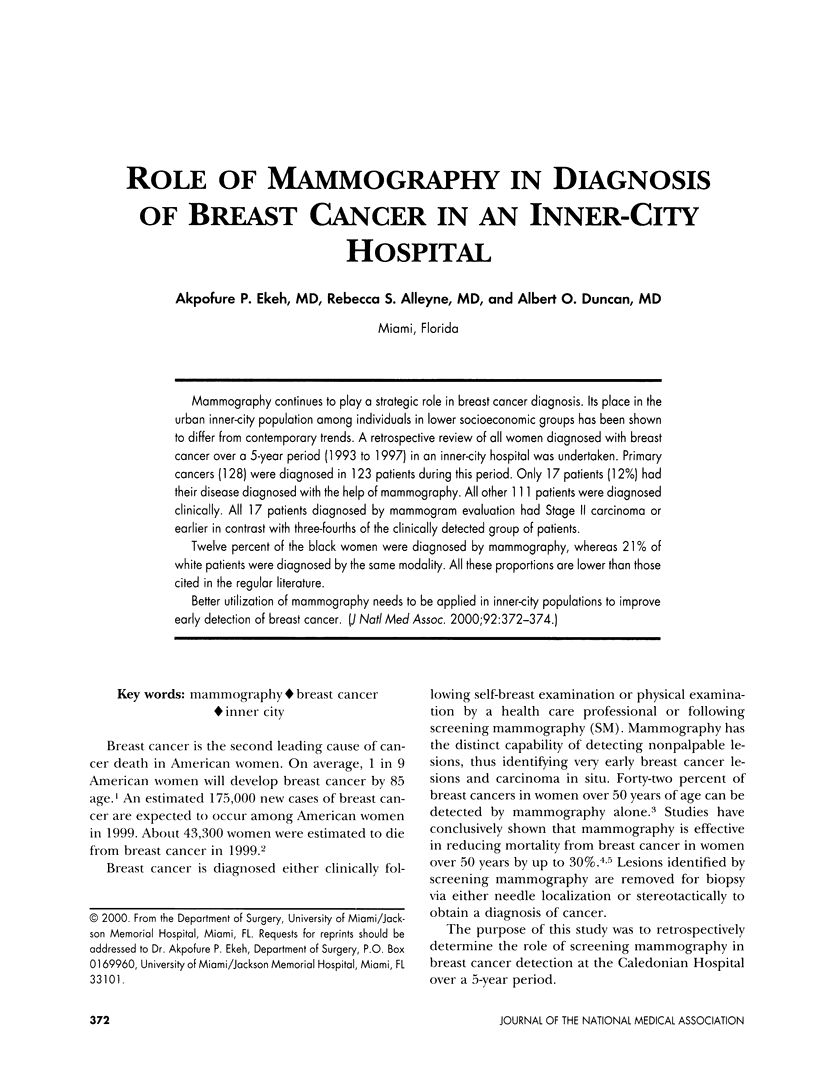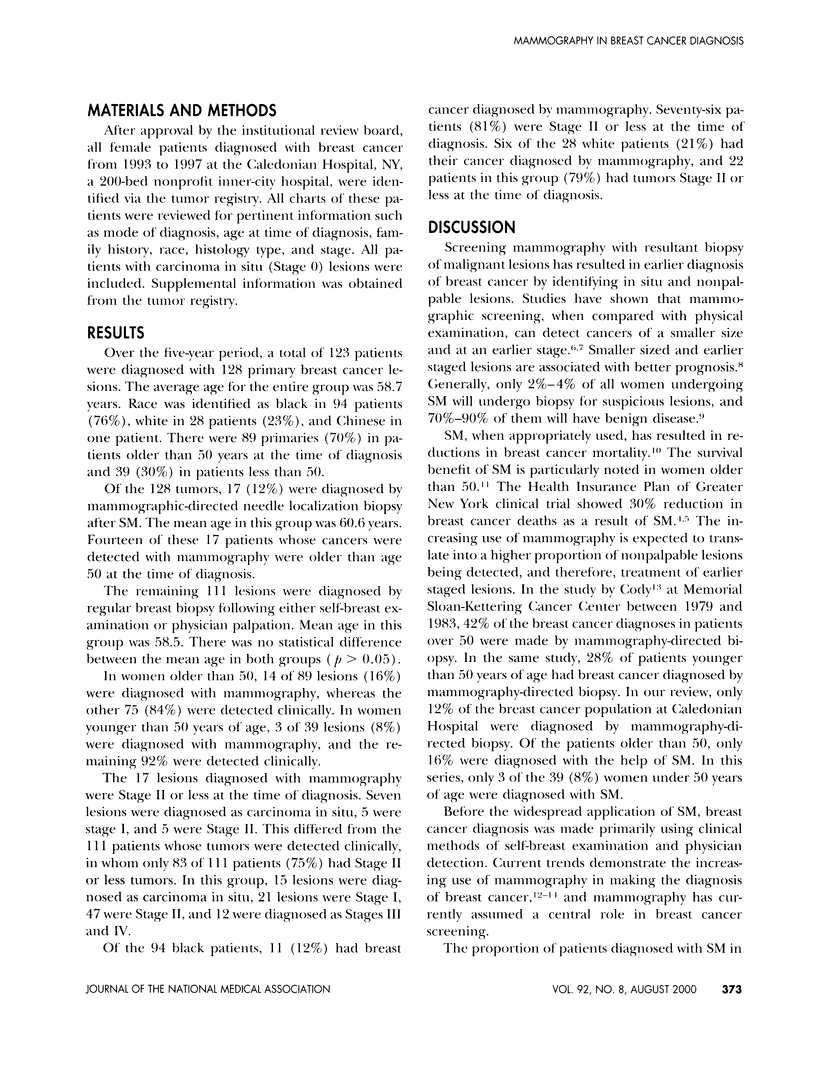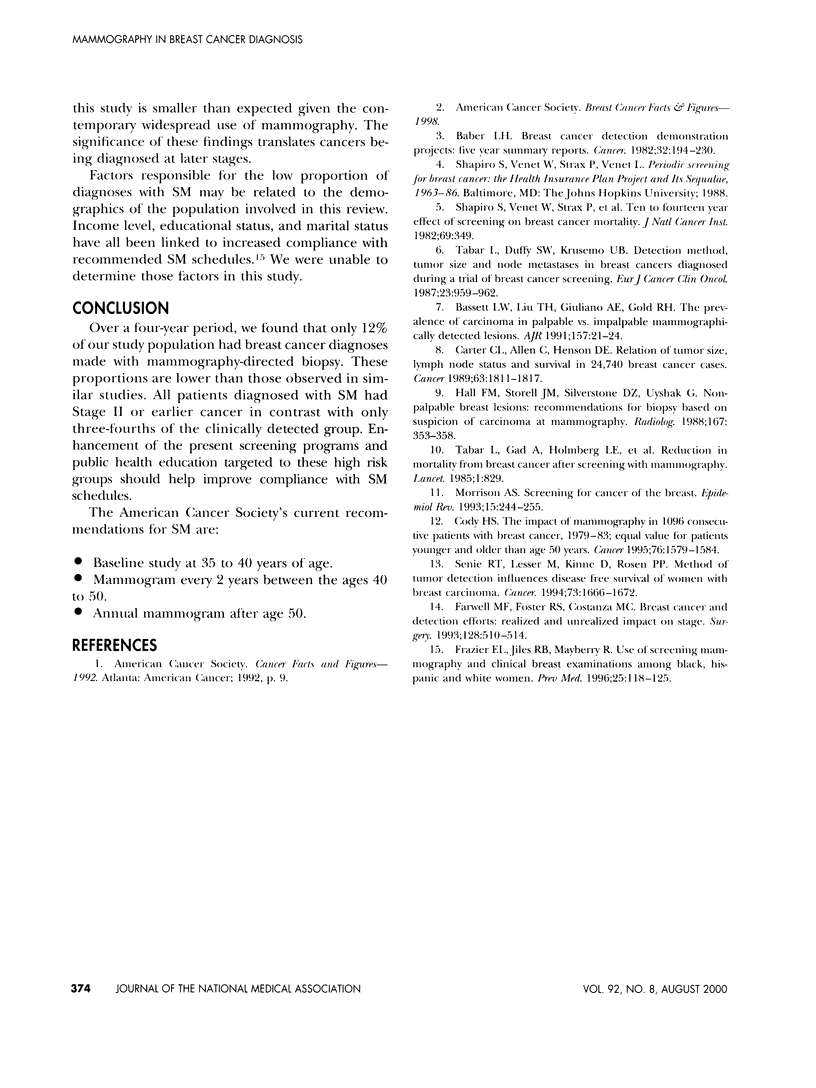Abstract
Mammography continues to play a strategic role in breast cancer diagnosis. Its place in the urban inner-city population among individuals in lower socioeconomic groups has been shown to differ from contemporary trends. A retrospective review of all women diagnosed with breast cancer over a 5-year period (1993 to 1997) in an inner-city hospital was undertaken. Primary cancers (128) were diagnosed in 123 patients during this period. Only 17 patients (12%) had their disease diagnosed with the help of mammography. All other 111 patients were diagnosed clinically. All 17 patients diagnosed by mammogram evaluation had Stage II carcinoma or earlier in contrast with three-fourths of the clinically detected group of patients. Twelve percent of the black women were diagnosed by mammography, whereas 21% of white patients were diagnosed by the same modality. All these proportions are lower than those cited in the regular literature. Better utilization of mammography needs to be applied in inner-city populations to improve early detection of breast cancer.
Full text
PDF


Selected References
These references are in PubMed. This may not be the complete list of references from this article.
- Bassett L. W., Liu T. H., Giuliano A. E., Gold R. H. The prevalence of carcinoma in palpable vs impalpable, mammographically detected lesions. AJR Am J Roentgenol. 1991 Jul;157(1):21–24. doi: 10.2214/ajr.157.1.1646562. [DOI] [PubMed] [Google Scholar]
- Cody H. S., 3rd The impact of mammography in 1096 consecutive patients with breast cancer, 1979-1993: equal value for patients younger and older than age 50 years. Cancer. 1995 Nov 1;76(9):1579–1584. doi: 10.1002/1097-0142(19951101)76:9<1579::aid-cncr2820760913>3.0.co;2-g. [DOI] [PubMed] [Google Scholar]
- Farwell M. F., Foster R. S., Jr, Costanza M. C. Breast cancer and earlier detection efforts. Realized and unrealized impact on stage. Arch Surg. 1993 May;128(5):510–514. doi: 10.1001/archsurg.1993.01420170040005. [DOI] [PubMed] [Google Scholar]
- Frazier E. L., Jiles R. B., Mayberry R. Use of screening mammography and clinical breast examinations among black, Hispanic, and white women. Prev Med. 1996 Mar-Apr;25(2):118–125. doi: 10.1006/pmed.1996.0037. [DOI] [PubMed] [Google Scholar]
- Hall F. M., Storella J. M., Silverstone D. Z., Wyshak G. Nonpalpable breast lesions: recommendations for biopsy based on suspicion of carcinoma at mammography. Radiology. 1988 May;167(2):353–358. doi: 10.1148/radiology.167.2.3282256. [DOI] [PubMed] [Google Scholar]
- Morrison A. S. Screening for cancer of the breast. Epidemiol Rev. 1993;15(1):244–255. doi: 10.1093/oxfordjournals.epirev.a036111. [DOI] [PubMed] [Google Scholar]
- Shapiro S., Venet W., Strax P., Venet L., Roeser R. Ten- to fourteen-year effect of screening on breast cancer mortality. J Natl Cancer Inst. 1982 Aug;69(2):349–355. [PubMed] [Google Scholar]
- Tabar L., Duffy S. W., Krusemo U. B. Detection method, tumour size and node metastases in breast cancers diagnosed during a trial of breast cancer screening. Eur J Cancer Clin Oncol. 1987 Jul;23(7):959–962. doi: 10.1016/0277-5379(87)90341-5. [DOI] [PubMed] [Google Scholar]
- Tabár L., Fagerberg C. J., Gad A., Baldetorp L., Holmberg L. H., Gröntoft O., Ljungquist U., Lundström B., Månson J. C., Eklund G. Reduction in mortality from breast cancer after mass screening with mammography. Randomised trial from the Breast Cancer Screening Working Group of the Swedish National Board of Health and Welfare. Lancet. 1985 Apr 13;1(8433):829–832. doi: 10.1016/s0140-6736(85)92204-4. [DOI] [PubMed] [Google Scholar]


